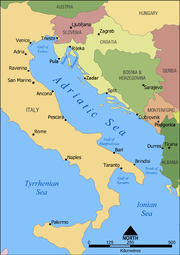The Adriatic Sea is a body of water separating the Apennine peninsula from the Balkan peninsula, and the system of the Apennine Mountains from that of the Dinaric Alps and adjacent ranges. The Adriatic Sea is a part of the Mediterranean Sea.
The western coast is Italian, while the eastern coast runs mostly along Croatia, but lesser parts belong to Italy, Slovenia, Bosnia and Herzegovina, Montenegro, and Albania.
Name and etymology
The Adriatic extends northwest from 40° to 45° 45' N., with an extreme length of about 770 km (415 nm, 480 mi). It has a mean breadth of about 160 km (85 nm, 100 mi), although the Strait of Otranto, through which it connects at the south with the Ionian Sea, is only 45-55 nautical miles wide (85-100 km).
Moreover, the chain of islands which fringes the northern part of the eastern shore reduces the extreme breadth of open sea in this part to 145 km (78 nm, 90 mi). Its total surface area is about 60,000 square miles (160,000 km²).
The northern part of the sea is very shallow, and between the southern promontories of Istria and Rimini the depth rarely exceeds 46 m (25 fathoms). Between Šibenik and Ortona a well-marked depression occurs, a considerable area of which exceeds 180 m (100 fathoms) in depth.
From a point between Korčula and the north shore of the spur of Monte Gargano there is a ridge giving shallower water, and a broken chain of a few islets extends across the sea.
The deepest part of the sea lies east of Monte Gargano, south of Dubrovnik, and west of Durrës where a large basin gives depths of 900 m (500 fathoms) and upwards, and a small area in the south of this basin falls below 1,460 m (800 fathoms). The mean depth of the sea is estimated at 240 m (133 fathoms).
 Extent and Bathymetry
Extent and BathymetryThe west shore is generally low, merging, in the northwest, into the marshes and lagoons on either hand of the protruding delta of the river Po, the sediment of which has pushed forward the coastline for several miles within historic times -- Adria is now some distance from the shore.
On islands within one of the lagoons opening from the Gulf of Venice, Venice has its unique situation. Other notable cities on the Italian coast are Trieste, Ravenna, Rimini, Ancona, Pescara, Bari and Brindisi.
The east coast is generally bold and rocky, with many islands. South of the Istrian Peninsula, which separates the Gulfs of Venice and Gulf of Trieste from the Bay of Kvarner, the island-fringe of the east coast extends as far south as Dubrovnik.
The islands, which are long and narrow (the long axis lying parallel with the coast of the mainland), rise rather abruptly to elevations of a few hundred feet, with the exception of a few larger islands like Brač (Vidova gora, 778 m) or the peninsula Pelješac (St. Ilija, 961 m). There are over a thousand islands in the Adriatic, 66 of which are inhabited.
On the mainland, notably in the magnificent inlet of the Gulf of Kotor (Boka Kotorska, Bocche di Cattaro; named after the town of Kotor), lofty mountains often fall directly to the sea.
The prevalent colour of the rocks is a light, dead grey, contrasting harshly with the dark vegetation, which on some of the islands is luxuriant. In fact, Montenegro (Black Mountain) was named after the black pines that cover the coast there, and similarly the Greek name for the island of Korčula is Korkyra Melaina meaning "Black Corfu".
Major cities on the northeastern coast include Trieste in Italy; Izola, Koper, Piran and Portorož in Slovenia; Umag, Poreč, Rovinj, Pula, Opatija, Rijeka, Senj, Zadar, Biograd, Šibenik, Trogir, Split, Makarska, Ploče and Dubrovnik in Croatia; Neum in Bosnia and Herzegovina; Herceg Novi, Kotor, Tivat, Bar, Budva and Ulcinj in Montenegro; and Durrës in Albania.
No comments:
Post a Comment